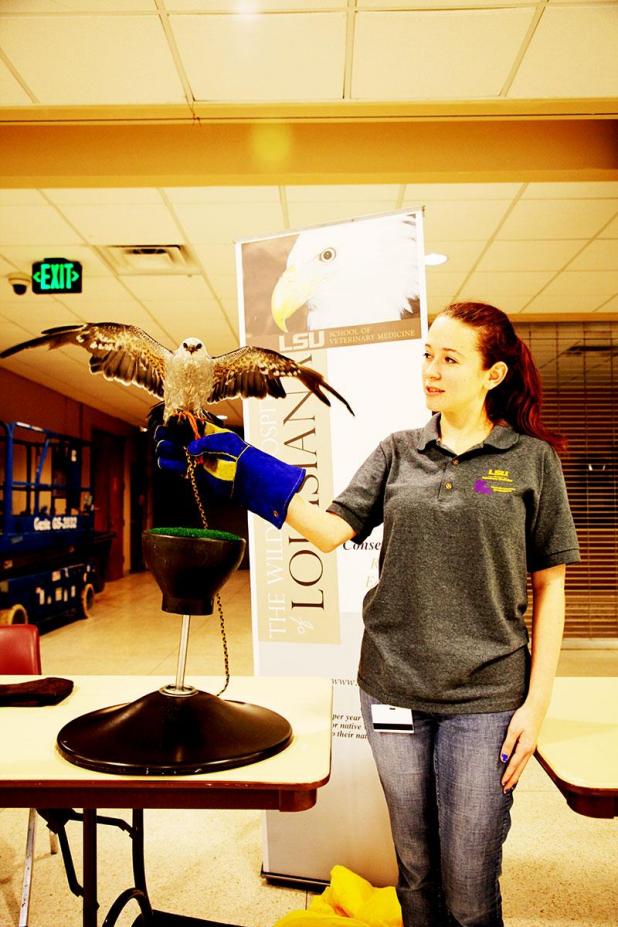
Alexis Caillouet of the LSU School of Veterinary Medicine's Wildlife Hospital with Skyler the Mississippi kit during Saturday's Water and Nature portion of the 13th annual Eagle Expo. (Submitted Photo/Courtesy of John K. Flores)
Water and nature program was something not to miss
There’s nothing that aggravates me more than someone saying to me, “You missed it” or “You should have been there.”
My usual response is something to the effect of, “Yeah-yeah-yeah, I know. So why you gotta rub it in?”
So now it’s my turn. If you missed last weekend’s Water and Nature portion of the 13th Annual Eagle Expo and More, “YOU MISSED IT. YOU SHOULD HAVE BEEN THERE!”
Sorry, just saying. Because what the Cajun Coast Convention and Visitors folks put on for the public this year was nothing short of outstanding and a whole lot of fun for everyone.
Last Saturday during the nature and water event, I met a young lady from the LSU School of Veterinary Medicine’s Wildlife Hospital named A l e x i s C a i l l o u e t . Perched on her arm was a 2-year old female Mississippi kite named Skyler. According to Caillouet, Skyler imprinted on humans and no longer will feed in the wild. If you weren’t there, “You missed it” is all I’m trying to convey.
Caillouet, a second-year veterinary student, said, “So Skyler doesn’t realize she is a bird. She kind of identifies as a human, which doesn’t mean she’s nice to humans. She will harass people for food. So,
that’s why we can’t release her, because we don’t want her going up to people who might potentially harm her.”
You should have been there to see Bayou Teche National Wildlife Refuge Manager Brian Pember showing off some of the wildlife found on the refuge. For impressionable children, it’s all about touching things in their learning process. He literally had the young children attending captivated with a small alligator, a softshell turtle and a red-eared slider turtle.
Pember patiently allowed and even encouraged the kids to touch the reptiles, who didn’t seem worse for wear after receiving so much attention.
Morgan City historically has been a hub for offshore energy supplies, services and deep-water construction dating back to the late 1930s and 40s. Bryce Merrill, curator for the Diving & R.O.V. H i s t o r i c a l Preservation Museum, in Morgan City, brought an interesting display of historic pieces of equipment. Merrill made a career out of diving, working for Oceaneering, International.
You should have been there for breakfast and Katie Percy’s lecture on geolocator tracking of prothonotary warblers. If you weren’t, you missed it.
Percy is an avian biologist with Audubon Louisiana and has been working with Dr. Erik Johnson for the past several years, attaching geolocator devices on this particular neotropical songbird to learn more about its migration pattern. Determining their migration routes and wintering areas are critical steps in identifying habitats used by the species.
Percy said since the 1960s, 40 percent of the prothonotary warbler’s population has declined. Estimated at 1.6 million, they are a species of concern. Geolocators record the approximated latitude
and longitude of a bird’s travels. The information cannot be wirelessly or remotely transmitted. Instead, it is stored on the device until it can be retrieved from the bird and manually downloaded.
In June of 2013, one male prothonotary warbler traveled some 5,000 miles through seven countries, winding up in Columbia. It returned to its breeding territory in Louisiana on March 23, 2014. The bird was captured, and the important data recovered.
Percy says 25 percent of the population of prothonotary warblers breed in Louisiana, particularly along the Mississippi alluvial plain. Ten percent of that population lives along the coastline.
Following Percy was Phillip Vasseur, a biologist with the Louisiana Department of Wildlife and Fisheries, who works out of the Rockefeller Wildlife Refuge office in Grand Chenier. Vasseur updated
the group on the status of the whooping cranes.
Since 2011, 125 whooping cranes have been released between White Lake Conservation Area and Rockefeller Wildlife Refuge. Survivorship stands at around 50 percent, with large losses occurring as a result of predation (10) and gunshots (11) through the years.
But, in spite of some setbacks, the department remains positive. In 2016, for the first time in 75 years, a whooping crane chick hatched on the Louisiana landscape. Currently, there are several nesting pairs.
The department has established a goal of 120 to 132 whooping cranes for the non-essential experimental population in southwest Louisiana.
Moreover, of that number, they hope to have 25 to 30 breeding pairs.
Perhaps the biggest highlight of the 13th Annual Eagle Expo’s Saturday Water and Nature Expo day was the Wings to Soar educational program that was free to the public. If you didn’t get a chance to see the program, you missed it.
There were other things to see and do at Saturday’s event, which also had plenty of giveaways, too. If you missed it, not to worry. I’m sure the good people at the Cajun Coast Visitors and Convention Bureau are already cooking up next year’s event with the turn out they had this year. Hopefully next year, you won’t.
EDITOR’S NOTE: Flores is The Daily Review’s outdoor editor.
